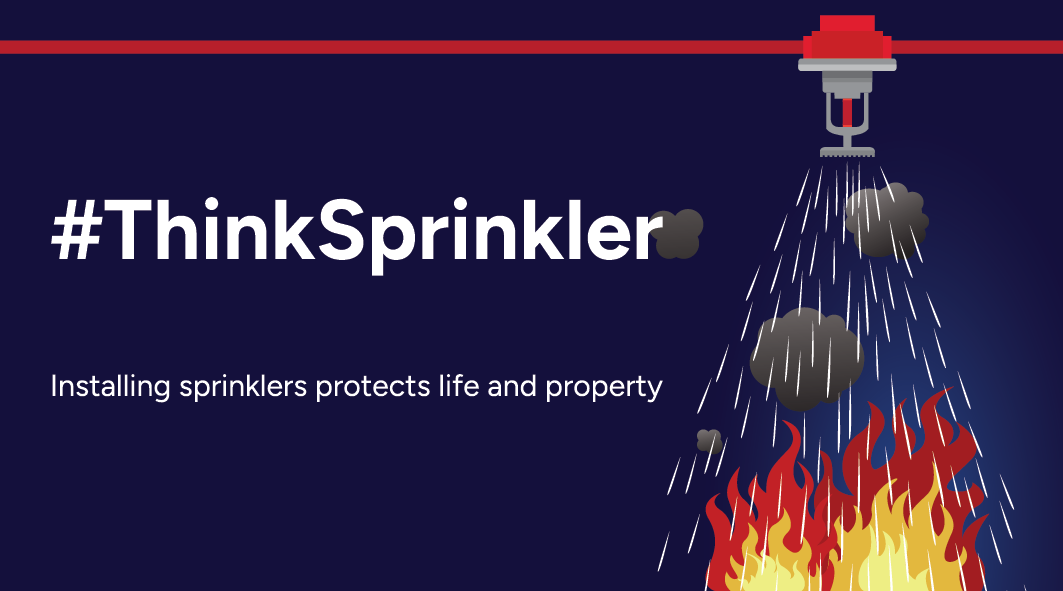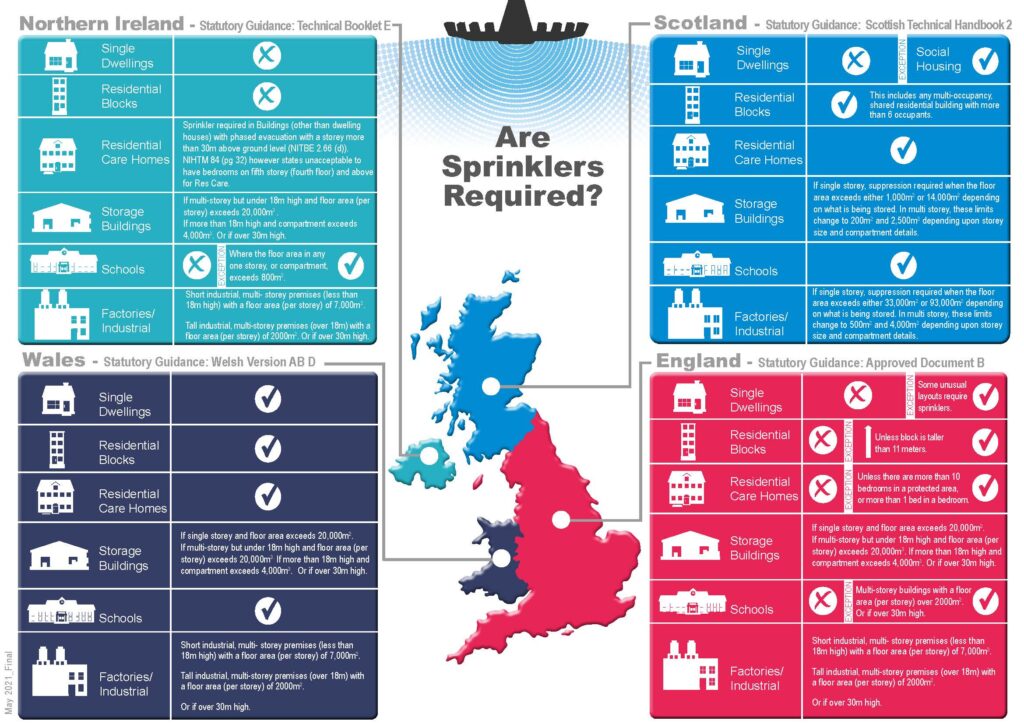Sprinklers
Sprinklers:
- Save lives and property
- Improve firefighter safety
- Minimise environmental damage
- Reduce economic loss

A fire sprinkler is a piece of equipment that discharges water when it detects fire or any other effects of fire, such as high temperatures. Evidence shows that having a functioning sprinkler system is an effective way of stopping fires from spreading, protecting lives and businesses.
What type of premises are sprinklers suitable for?
Sprinkler systems may be included in the planning and design stage of a building under development from which there are significant benefits. They may also be retro-fitted into buildings (commercially or domestically) to enhance its fire safety measures.
Premises which would benefit from installing a sprinkler system include:
- Care homes
- Schools and places of further education
- Heritage buildings
- Hospitals
- Domestically, particularly where the occupants are vulnerable or have poor mobility
- Specialist housing
- Residential properties over 18m in height – including student accommodation
- Hotels, B&Bs and hostels
- Large warehouses which have large amounts of combustibles or use hazardous processes
- Complex and deep sub surface structures such as basements
What types of Sprinkler systems are there?
- Wet pipe system
This is the most common type of sprinkler system, where water is immediately available in the pipe and is supplied from an automatic pressure fed supply. The sprinkler head activates at a specific temperature to combat the effects of fire.
- Dry pipe system
These systems are usually installed in places where environmental factors might cause pipes to normally freeze, such as basements or garages.
- Deluge system
In this sprinkler system, rather than a specific sprinkler head activating, all the sprinkler heads are open allowing a deluge of water to flow, particularly useful over a large area which uses a hazardous process.
- Water mist systems
This sprinkler system is more appropriate to use if there is a minimal water supply and can suppress fires whilst minimising the impact of water damage in a premises.
How does a sprinkler work?
British Automatic Fire Sprinkler Association (BAFSA) campaign for sprinklers in schools in England: Sprinklers in schools information file
Are sprinklers required?

HWFRS endorses the NFCC’s position statement on sprinklers, that “they are the most effective way to ensure that fires are suppressed or even extinguished before the fire service can arrive”
National Fire Chiefs Council: Position Statement on Sprinklers
As such, part of HWFRS Protection strategy is to promote the introduction of sprinklers. HWFRS will:
- Proactively promote the installation of Sprinklers within all potentially high-risk commercial and residential premises
- Work with local Building Control Bodies to promote their use in all high-risk buildings
- Work alongside developers, local authorities, housing providers and landlords to support the installation of Automatic Fire Suppression Systems (AFSS) in building stock
Myth 1
“In a fire, every sprinkler head will activate and flood my property”
Individual sprinkler heads will only activate when the room temperature reaches a certain point. The heads operate as individual heat sensors and water is only released in the area where there is a fire. In 60% of cases, fires are controlled by the spray from four sprinklers or fewer. Firefighters often use 15 times more water from hoses to do the same job as one sprinkler does.
Myth 2
“Sprinklers are too expensive to install”
In new building the costs of installing sprinklers, considered over the lifespan of the building, works out roughly the same as carpeting the same building. The Local Government Association has worked out the cost of sprinklers in specific types of buildings:
125-150 pupil primary school: total costs approx. £105,000, equivalent to £10-15 per m2
Typical 3-4 bed house: total costs approx. £3,000-£3,500, equivalent to 1-2% of build costs
High-rise flats: total costs around 1.5-1.9% of build costs, equivalent to £18-25 per m2
It is also likely that insurers will offer premium discounts to premises with sprinkler systems and that policy excesses will be lower.
Myth 3
“Sprinklers are too expensive to maintain”
Annual maintenance costs of domestic fire sprinkler systems is between £75-£150 per year (£6.25-£12.50 per month). That’s a lot less than the cost of replacing home contents should a fire occur.
Myth 4
“Sprinklers are ugly and affect the design of a building”
Sprinklers actually allow design freedom if considered when a building is being built. They may allow larger rooms and a reduction in partitioning, or allow adaptation of layouts to better meet the occupier’s needs. Sprinklers can be recessed or flush-mounted and unobtrusive.
Myth 5
“Sprinklers are unreliable”
Worldwide records show that only 1 in 16 million sprinklers installed per year will result in failure. Every sprinkler head is independently tested before leaving the manufacturing plant.
Myth 6
“Sprinklers only work on fires that can be put out with water”
Sprinklers can now be foam enhanced to control flammable liquid, chemical and petroleum fires.